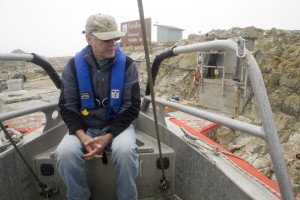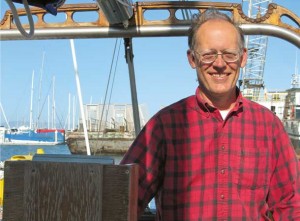There’s no way to address this and come out looking like a hero, so I won’t even try. I get seasick – violently, lamentably seasick. I lose all hope, all dignity when enmeshed in the coils of the variant of mal de mer that afflicts me every time I’m on a boat of middling size.

So, it was with some foreboding that I took an assignment from Bay Nature Magazine on the effects of climate change on the Farallon Islands. The crossing from San Francisco Bay is only 30 miles, but the transit would be by sail, and hence slow. I had made the trip before, and I knew I would suffer – and subject my boatmates to a disgraceful display.
Yes, I had to steel myself. But did I hesitate? Of course not. A trip to the Farallones is a rare privilege, and no one even remotely interested in the natural world would refuse the opportunity of a visit. Permits are difficult to come by; usually only scientists are allowed on the islands. So I stuck a scopolamine skin patch behind my ear, and left Port Richmond one cold, foggy morning on a supply boat with researchers from PRBO Conservation Science.
As any fisherman or whale-watcher knows, the Gulf of the Farallones is one of the most biologically productive marine environments in the world. Here, seasonal upwelling transports great volumes of nutrient-rich cold water close to the ocean’s surface. This, in turn, stimulates massive plankton blooms, which in turn sustain kilotons of krill, anchovies, and young rockfish. These forage species constitute a groaning board for everything from salmon to blue whales.
You can usually see some cetaceans on the way to the Farallones – sometimes a lot of them. On this particular, trip, however, all we saw were a few harbor porpoises close to the Golden Gate. As we hit the open water and the swell increased and the fog closed in, pigeon guillemots buzzed our boat. I started to feel pretty bilious, and by the time we reached the islands, I was limp as a noodle and green as alfalfa.
I quickly revived as we approached the islands. On a foggy day, you most definitely smell them before you see them. There are hundreds of thousands of birds and pinnipeds ingesting and excreting on the islands, and that makes for a powerful olfactory statement. First, you catch a slight waft, vagrant molecules of urea agglutinated to the billowing fog. This scent deepens in power and complexity as you continue your approach. And then you’re there, bobbing in the lee of Southeast Farallon Island, and you’re enveloped in a scent so rich, so deeply organic, that your eyes tear.
But only momentarily — you get used to the smell quickly. There’s no proper dock at the Southeast Island’s research station – the cliffs are so precipitous that shuttlecraft must be winched up to a landing. Once we were hauled up, we disembarked from our Zodiac and walked along the path that led to the two ramshackle, quasi-Victorian buildings that house the researchers. Cast against the strangely lunar landscape of the island, these structures seem vaguely threatening, like a horror movie set. Inside, they’re cozy, clean and warm: a much-appreciated refuge for the scientists who spend weeks, sometimes months, on this isolated rock, immured in their research.

Along the way, nesting Western Gulls nipped at our ankles. There are thousands of them here, constituting the largest Western Gull colony in the world. Their cries were almost deafening. Between the nests were windrows of bones – chicken bones, I’m told. The opportunistic gulls often fly to the mainland to forage, and have a something of a junk food addiction; they dote on KFC scraps.
Typically, visitors only get a few hours on the island – just enough time for the boat to unload supplies and gear, and give the crew a stretch. My trip was no exception. We marveled at the pinniped rookeries, watched researchers weigh Cassin’s auklet chicks after carefully removing them from nesting boxes, and crouched in a small blind to examine serene colonies of common murres from mere feet away.
All too soon, it was time to get back on the boat. I was glum at the prospect of another four-hour interlude of queasiness — but I was sadder still to leave this singular place. It is small in scope, but in terms of its significance to the conservation ethos, it ranks with the Serengeti, the north slope of the Brooks Range, the Amazon. There is no place like it. To be there is to understand wildness – even if you can see San Francisco on a clear day.
Glen Martin is the author of “Climate Chronicles: A Sea Change for Seabirds on the Farallones” in the October 2012 issue of Bay Nature Magazine. Martin is a former environmental reporter for the San Francisco Chronicle; his latest book is “Game Changer: Animal Rights and the Fate of Africa’s Wildlife,” published by UC Press in March 2012.



-300x200.jpg)
-300x225.jpg)